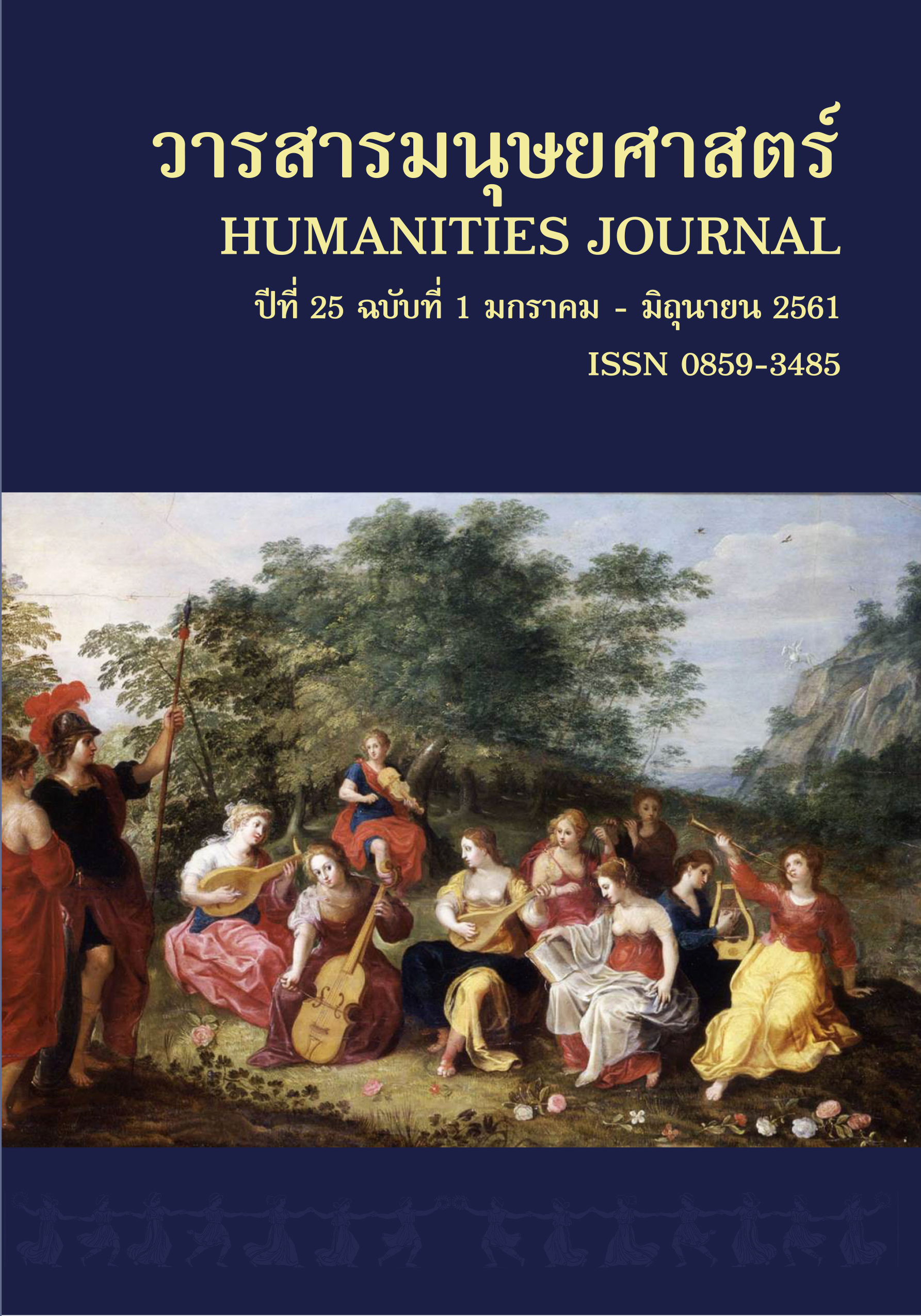Teachers’ Attitudes towards the Use of Graded Readers in Promoting English Reading Skills in Thai EFL Students A Case Study of Secondary School Teachers in Bangkok
Main Article Content
Abstract
This study aims to survey the use of Graded Readers in Thai secondary schools and to explore the attitudes of English language teachers towards the use of the materials in promoting reading skills in Thai secondary schools. The participants were 45 teachers of Foreign Languages Departments from 6 out of 66 secondary schools (9.09%) in Bangkok which used Graded Readers in English language teaching. The questionnaire and semi-structured interview were the major instruments. The descriptive and interpretive methods of content analysis (Coffey & Atkinson, 1996; Strauss & Corbin, 1998; Berg, 2004) were conducted for this study. The results revealed Graded Readers were commonly used as external reading (47%) to provide the students with an opportunity for extensive reading and promote their reading habits. However, these teachers seemed to lack awareness of the fact that Graded Readers could enhance the use of reading strategies. Yet, 53% of the teachers reported positive attitudes in the use of the materials in teaching strategies. Eight major reading strategies (e.g., building background knowledge, vocabulary building, skimming and identifying main ideas, generating questions, scanning and identifying supporting details, inferring meaning/interpreting, summarizing, and brainstorming) were reported to be substantially used among these teachers. Overall, the results of this study suggest that the schools should promote more effective reading instruction on the use of this material in improving reading skills in Thai students more effectively.
Article Details
References
Anderson, N. J. (1999). Exploring Second Language Reading: Issues and Strategies. Toronto, Canada: Heinle and Heinle.
Bailey, E. (2014). Making inferences: Improving reading comprehension for students with dyslexia. Retrieved from https://www.thoughtco.com/making-inferences-3111201.
Baker, W. (2012). English as a Lingua Franca in Thailand: Characterisations and implications. Englishs in Practice: Working Papers of the Centre for Global Englishes, 1(1), 18-27.
Beale, A. M. (2013). Skimming and scanning: Two important strategies for speeding up your reading. Retrived from https://www.howtolearn.com/2013/02/ skimming-and-scanning-two-important-strategies-for-speeding-up-your-reading/.
Berg, B. (2004). Qualitative Research Methods for the Social Sciences (5th ed.). USA: Pearson.
Bulushy, Z. A. (n.d.). The story behind Graded Readers. Retrieved from https://www.developingteachers.com/articles_tchtraining/graded1_zainab.htm
Carrell, P. L. (1989). Metacognitive Awareness and Second Language Reading. The Modern Language Journal, 73(2), 121-134.
Chawwang, N. (2008). An investigation of English reading problems of Thai 12th-grade students in Nakhonratchasima educational regions 1, 2, 3, and 7 (Master’s thesis). Srinakharinwirot University, Bangkok.
Chinwonno, A. (2001). A Comparison of Thai and English Reading Comprehension Strategies of Preservice Teacher in Thailand (Doctoral dissertation). Ohio University, USA.
Coffey, A., & Atkinson P. (1996). Making Sense of Qualitative Data: Complementary Research Strategies. Thousand Oaks, CA: Sage.
Creswell, J. (2009). Research Design: Qualitative, Quantitative, and Mixed Methods Approaches. (3rd ed.). California: Sage Publication.
Duffy, G. G. (2003). Explaining Reading: A Resource for Teaching Concepts, Skills, and Strategies. New York, NY: The Guilford press.
Duke, N. K., & Pearson, P. D. (2002). Effective practices for developing reading Comprehension. In A. E. Farstup & S. J. Samuels (Eds.), What research has to say about reading instruction (pp. 205-242). Retrieved from https://diagnosisfall2010.wikispaces.com/file/view/Duke+Pearson+ Comprehension.pdf.
Education Service Agencies region 6 & 7. (2006). On Target: Strategies to build student vocabularies. Retrieved from https://celi.olemiss.edu/wp-content/uploads/ sites/7/2014/01/ StrategiesVocabulary-080808.pdf.
Ghabanchi, Z., & Behrooznia, S. (2014). The impact of brainstorming on reading comprehension and critical thinking ability of EFL learners. Procedia-Social and Behavioral Sciences. 98, 513-521. Retrieved from https://www.sciencedirect.com/science/article/pii/S1877042814025385.
Herrmann, E. (2013). Background knowledge: Why is it important for ELL programs? Retrieved from https://www.multibriefs.com/briefs/exclusive/background _knowledge_1.html#.WPh-tfmGOUl.
Irwin, J. W. (1986). Teaching Reading Comprehension Processes. Englewood Cliffs, NJ: Prentice Hall.
Johnson, D., & Blair, A. (2003). The importance and use of student self-selected literature of reading engagement in an elementary reading curriculum. Reading Horizons, 43(3), 181-202.
Jones, R. (2012). Strategies for Reading Comprehension: Summarizing. Retrieved from https://www.readingquest.org/strat/summarize.html.
Kleinová, D. (2015). Graded Readers as a Tool to Raise Learners' Interest in Reading (Master’s thesis). Masaryk University, Czech Republic.
Kragler, S. (2000). Choosing books for reading: An analysis of three types of readers. Journal of research in childhood education, 14(2), 133. Küçükğlu, H. (2013). Improving reading skills through effective reading strategies. Procedia-Social and Behavioral Sciences. 70, 709-714.
Lysynchuk, L., Pressley, M., & Vye, N. (1990). Reciprocal teaching improves standardized reading comprehension performance in poor comprehenders. The Elementary School Journal, 90, 469-484.
McQuillan, J. (2016). What can readers read after graded readers? Reading in a Foreign Language, 28(1), 63-78.
Mikulecky, B. S. (2008). Teaching reading in a Second Language. Retrieved from https://www.longmanusahome.com/images/stories/monographs/FINAL-LO%20RES-Mikulecky-Reading%20Monograph%20.pdf
Ministry of Education of Thailand. (2008). The basic education core curriculum B.E. 2551 (A.D.2008). Retrieved from https://www.act.ac.th/document/1741.pdf
Navaee, M. S., & Asadi, M. (2015). The effect of brainstorming on reading comprehension of Iranian EFL learners. ICT & Innovations in Education- international electronic journal. 3(2), 26-34. Retrieved from https://ictejournal.com/Volume_3/Issue_2/ICTIEJ_32_3.pdf
Nomnian, S. (2014). English as the ASEAN lingua franca in Thai Higher Education. Veridian E-Journal. 7(4), 75-84.
Nourie, L. B., & Lenski, D. S. (1998). The (in)effectiveness of content area literacy instruction for Secondary pre-service teachers. The Clearing House: A Journal of Educational Strategies, Issues and Ideas. 71(6), 372-379.
Nuttall, C. (1996). Teaching Reading Skills in a foreign language. Oxford: Heinemann.
Roit, M. L. (n.d.). Effective teaching strategies for improving reading comprehension in k-3 students. Retrieved from https://ecommerce-prod.mheducation.com. s3.amazonaws.com/unitas/school /explore/literacy-for-life/white-paper-ocr-effective-strategies-for-improving-reading-comprehension.pdf.
Souhila, R. (2014). The use of reading strategies in improving reading comprehension: the case of first year LMD English students (Unpublished Master’s thesis). University of Ouargla, Algeria.
Strauss, A., & Corbin J. (1998). Basics of Qualitative Research: Techniques and Procedures for Developing Grounded Theory. (2nd ed.). Thousand Oaks, CA: Sage.
Waring, R. (2000). Graded Readers: The ‘Why’ and ‘How’ of using Graded Readers. Retrieved from https://extensivereading.net/docs/tebiki_GREng.pdf
Waring, R. (n.d.). Writing a Graded Reader. Retrieved from www.robwaring.org/papers/Writing_graded_reader.doc
Woolley, G. (2011). Reading Comprehension. Reading comprehension: Assisting children with learning difficulties. Retrieved from https://www.springer.com/cda/content/document/cda_downloaddocument/9789400711730-c1.pdf?SGWID=0-0-45-1158048-p174102871.


